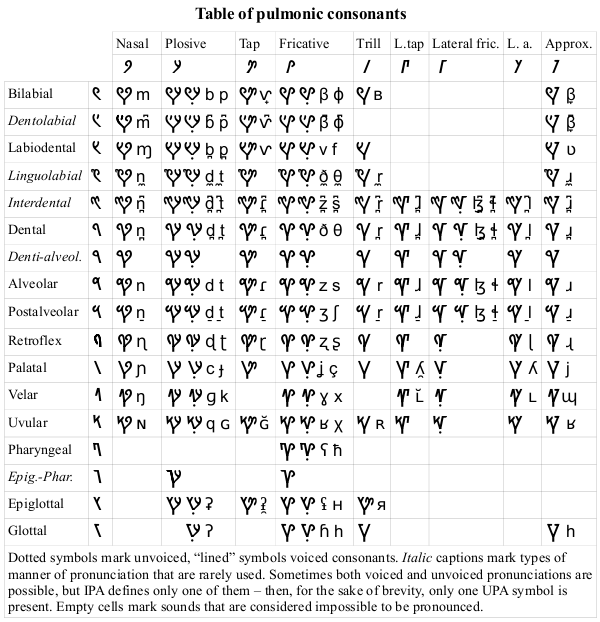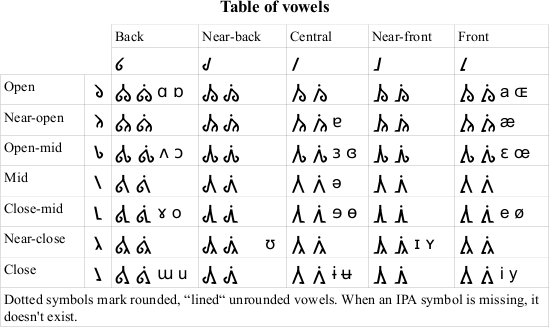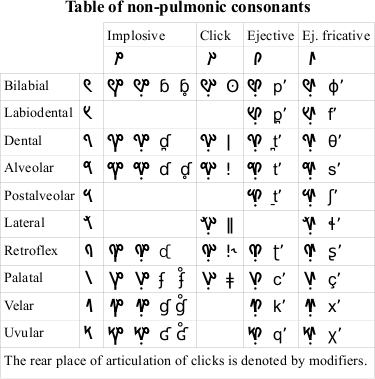The Universal Phonetic Alphabet was invented by Jakub Marian, who has always wondered why the International Phonetic Alphabet is based on the Latin alphabet. Not only is the Latin alphabet far from international; its shapes are not related to their sounds either. Not to mention that by adding all those diacritical marks, hooks etc. it becomes quite ugly. The aim of this construction is to create a visually appealing phonetic alphabet that is more universal than the IPA but much easier to master, since it is based on a logical symbol construction process.
Consonants are defined by two "large" parameters and one "small" parameter - manner of articulation and place of articulation are the large parameters in the sense that there are many possible combinations of both, and being voiced/voiceless is the small parameter (since it takes only two possible values). For the indication of the value the following symbols are used:
![]()
The slash-like symbol is sort of central, the rounded symbols are somewhat opposite of the spiky ones. However, they also maintain a linguistical logic. There will actually be more symbols, but those additional symbols are used for rarely used (and sort of complementary) concepts.
In the table of pulmonic consonants you can see probably all simple pulmonic consonants that a human can produce. The place of articulation axis is sorted by increasing depth in mouth/throat. The manner of articulation axis is sorted by increasing air flow through mouth.

Not all pulmonic consonants are of this kind. Some consonants are doubly articulated - t͡s, d͡z, t͡ʃ and d͡ʒ being the most common. These are marked in UPA by joining the bottoms of the two consonants, like (for the four mentioned):
![]()
From this notation you immediately see that d͡ʒ is only a voiced t͡ʃ etc.
Some consonants are only coarticulated (second articulation is done in the same manner). The second place of articulation is denoted by a modifier symbol attached to the consonant on the left. So, labialized (dʷ), labio-velarized (dʷ), velarized (dˠ), labio-palatalized (dɥ), palatalized (dʲ), and pharyngealized (dˁ) d would be:
![]()
Nasalization of a consonant is denoted as if it were "glottalization":
![]()
Probably the most important concept for an English speaker is w and ʍ. Those are labialized velar approximants and would be written:
![]()
Another important concept is the release. Nasal release (dⁿ) is marked by attaching the nasal symbol to the right, voiceless aspiration (tʰ) is marked as "approximal release", voiced (dʱ) then by adding a line to voiceless, lateral release (dˡ) by adding a lateral symbol and no audible release (d̚) by adding a dot:
![]()
Vowels form another important concept. Again, they are characterized by two large and one small parameters - closeness and frontness being the large, roundedness being the small.
In the table of vowels the frontness axis should be understood just as a parameter being relative to the position "as front as possible" for the current closeness (it is not possible to pronounce fully open and front a).

Reverse symbols for vowels allow us not only to use the same components as for consonants, but also provide a good basis for kerning. Look at the following example that shows the word international (written as ɪntənæʃənəɫ):
![]()
It is esthetically very pleasant.
Diphthongs are in the IPA written using diacritics. English contains for example ɔɪ̯, aɪ̯, ʊə̯. In the UPA, diphthongs are formed by joining the two characters by an arc. The three mentioned would be:
![]()
Triphthongs are marked in the same manner, ɔɪ̯ə would be:
![]()
The length modifier is a small line on top of a vowel. In British English "are" is pronounced [ɑː]. In UPA, this is written:
![]()
Nasalization is denoted in the similar way as the nasal release for consonants, ã would be:
![]()
To make our list of possible sounds complete, we need to consider non-pulmonic consonants:

Stresses are indicated in the same manner as in the IPA, that is by a small preceding line (either top or bottom), like
![]()
in the word ɪntə'næʃənəɫ. Tones could be indicated by some diacritics above the letters. Punctuation in longer texts may be written in any way that suits one's needs, however Jakub recommends using a vertical line instead of dot and a "half vertical line" instead of comma, like:
![]()
This is a sample text in English (without stresses), written in the UPA, the IPA and the Latin alphabet:

ɔːl hjuːmən biː.ɪŋz ɑː bɔːn friː ænd iːkwəɫ ɪn dɪgnɪti ænd raɪts. ðeɪ ɑː ɪndaʊd wɪθ riːzn ænd kɒn ʃns ænd ʃʊd ækt təwɔːdz wʌn ənʌðə ɪn ə spɪrɪt ɒv brʌðəhʊd.
All human beings are born free and equal in dignity and rights. They are endowed with
reason and conscience and should act towards one another in a spirit of brotherhood.
(Article 1 of the Universal Declaration of Human Rights)
Constructed scripts for: Ainu | Arabic | Chinese languages | Dutch | English | Hawaiian | Hungarian | Japanese | Korean | Lingala | Malay & Indonesian | Persian | Tagalog / Filipino | Russian | Sanskrit | Spanish | Taino | Turkish | Vietnamese | Welsh | Other natural languages | Colour-based scripts | Tactile scripts | Phonetic/universal scripts | Constructed scripts for constructed languages | Adaptations of existing alphabets | Fictional alphabets | Magical alphabets | A-Z index | How to submit a constructed script
[top]
You can support this site by Buying Me A Coffee, and if you like what you see on this page, you can use the buttons below to share it with people you know.

If you like this site and find it useful, you can support it by making a donation via PayPal or Patreon, or by contributing in other ways. Omniglot is how I make my living.
Note: all links on this site to Amazon.com, Amazon.co.uk
and Amazon.fr
are affiliate links. This means I earn a commission if you click on any of them and buy something. So by clicking on these links you can help to support this site.
[top]